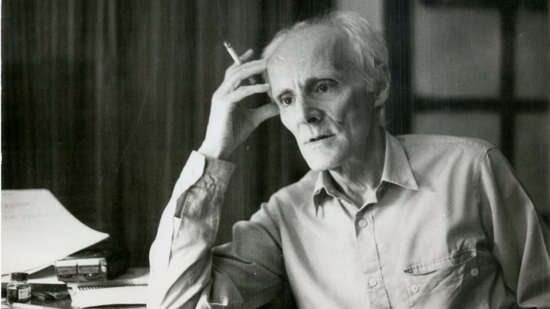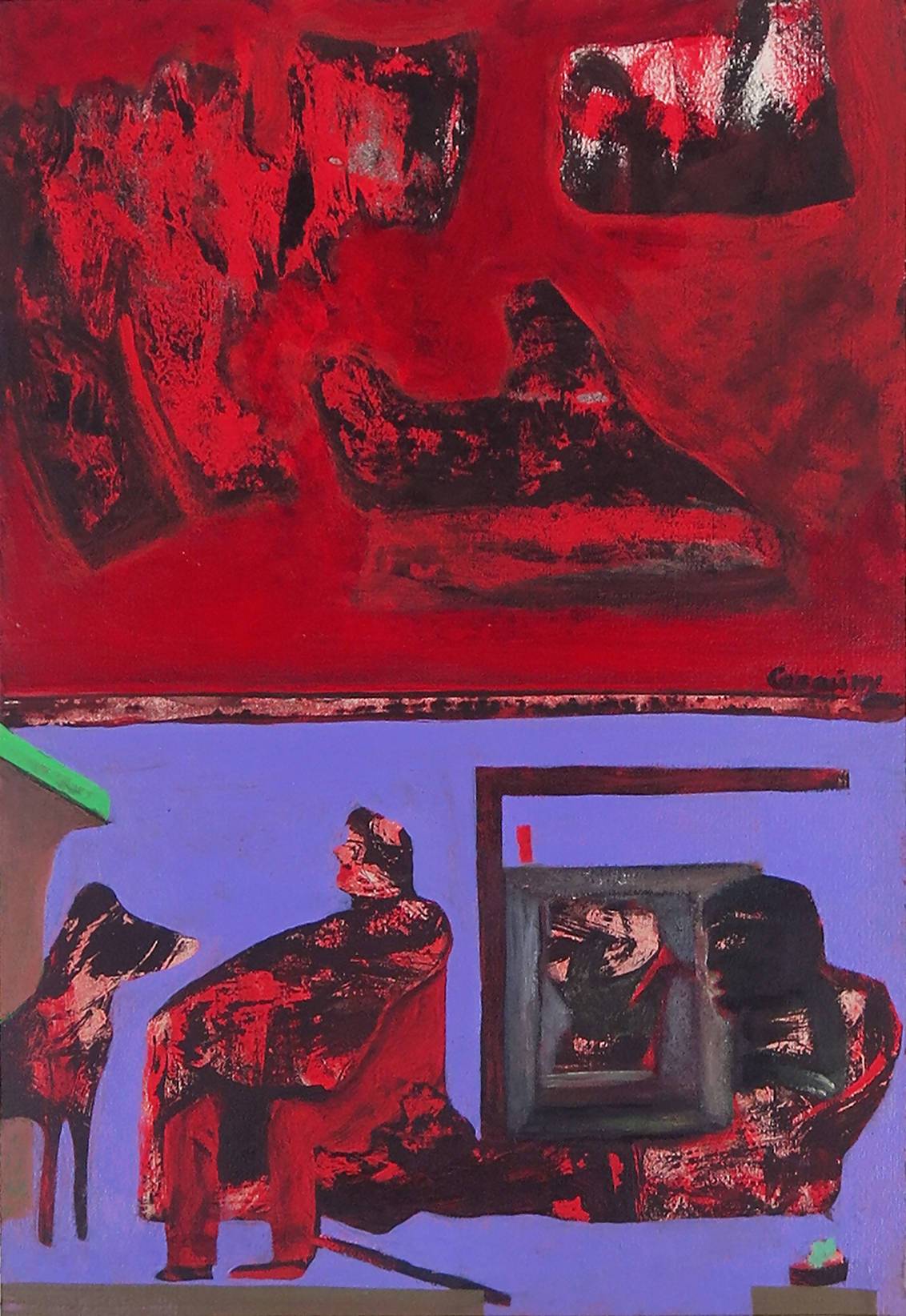
Mário Cesariny was born on August 9, 1923 in Lisbon. Attended the School ofDecorative Arts António Arroio and studied music with composer Fernando LopesGrace. By the age of 19, he was already writing, painting and drawing. He attended the first year of Architecture at the Escola Superior de Belas Artes in Lisbon, later at the Escola António Arroio, where he met some of the future companions of Portuguese surrealism. He became involved, for a short time, in the neorealist current. In Paris, he is a student at the Academie de La Grande Chaumiére, where he ended up meeting the founder and author of the manifesto of French surrealism André Breton. This event in 1947 forever changed the life of Mário Cesariny, being a decisive moment in the development of his literary work. He returned to Portugal with the will to transgress and challenge the powerful machine of the dictatorship. He wanted to be free in his country. In the year of his return, in 1947, he joined the Surrealist Group of Lisbon, where Alexandre O´Neill, Marcelino Vespeira, António Pedro, Cândido Costa Pinto, João Moniz Pereira.

Some time later, as he did not agree with the ideological line of the group, he left in a controversial way and founded the "Grupo Surrealista Dissident", with Pedro Oom, Cruzeiro Seixas, António Maria Lisboa, among others. They wrote a collective manifesto “A Fixação Proibida” and promoted the first exhibition of the Surrealists. These are times of affirmation of a movement that Mário Cesariny he would occupy himself later, when he decided to write the history of surrealist activities in Portugal. In Surrealism, Cesariny found the space of creative freedom he was looking for. Here it was for the dream, for the imagination, for love, based on the technique of psychic automatism and chance, without aesthetic or moral impositions. Everything is in line with his restless, controversial, subversive personality.

Main representative of Portuguese Surrealism, Mário Cesariny, at the beginning of his literary production, was influenced by Cesário Verde and by the Futurism of Álvaro de Campos, Fernando Pessoa's heteronym. By joining the Surrealist Group, he changed his style, bringing the "absurd", the "unusual" and "the unbelievable" to his work. Besides being a poet, novelist, essayist and playwright, he also dedicated himself to the visual arts. , especially to painting.He translated his life into writing and painting, languages he explored in the grammar of surrealism. Mário Cesariny is perhaps the most genuine militant of this movement in Portugal. He promoted the technique known as "weird cadaver", which consisted of the elaboration of a work by a group of people, in a creative chain process, in which each person continued the creativity of the previous one, resulting in a kind of collage of words, based on just an initial agreement on the sentence structure.

He collaborated in several periodical publications such as Jornal de Letras e Artes and Cadernos do Meio-Dia, among others. He began to be interested in the neorealist movement - although this brief incursion did not go beyond an ironic and parodic posture, established in Nicolau Cansado Escritor - to, in 1947, returned from Paris, where he attended the Academy of La Grande Chaumière and where he met André Breton, founding the Portuguese surrealist movement. His controversial stance in defense of authentic surrealism led him, however, to leave the group the following year, to create, with Pedro Oom and António Maria Lisboa, the dissident surrealist group. As one of the main critics and theorists of the surrealist movement, throughout his career he maintained numerous literary polemics, both against surrealism's detractors and against those who, in literary practice, distorted it.

His poetic work began by reflecting, in Corpo Visível or Discurso Sobre a Reabilitação do Real quotidiano, the taste for the ironic observation of urban reality which, echoing Cesário Verde, still constitutes an insignificant phase in relation to volumes close to practical surrealist as Handbook of Sleight of Hand. There, the mordacity and the absurd, the use of the unusual, allied to a discursivity that rarely embarks on a radical nonsense, as in the work of António Maria Lisboa, allow to establish, like no other author of the 50s, a point of balance between early modernism and the surrealist revolution.

With regard to his painting, it makes no sense to make a general theory. Like poetry, Cesariny's painting is spontaneous and subversive, marked by a somewhat magical and dreamlike dimension, with a predominance of color, disorder or chaos associated with the automatism and chance characteristic of surrealism. The use of "non-sense" and the absurd, so dear to the first vanguards, appear in his pictorial work, but also in the objects and "assemblages", along with an aesthetic attitude of experimentation, through the use of less conventional methods (collages, water paints) but which translate into a consistent plastic work. Defender and promoter of a surrealist movement in Portugal, Cesariny influenced several Portuguese artists, having seen his contribution to Portuguese art of the 20th century recognized with the attribution of the EDP 2002 Grand Prize.

In terms of theatre, Um Auto Para Jerusalem, a pastiche of a short story by Luís Pacheco, reveals the influence of Pirandello or the theatrical practice of Alfred Jarry. At the end of the 1960s and beginning of the 1970s, Mário de Cesariny began a work of restoring the historical truth of the surrealist movement, collecting its manifestos, editing the unpublished poetic work of some of its representatives, and publishing his texts dated from the period of greater involvement with the theory and practice of surrealism, such as 19 Aldonso Ortigão Prize Projects followed by Poemas de Londres (1971), or Primavera Autónoma das Estradas (1980) or Titania (1977). In 2005, he received the Grand Cross of the Order of Liberty, awarded by the then President of the Republic, Jorge Sampaio, and, in November of that same year, he was awarded the Vida Literária Grand Prize, a tribute to his outstanding contribution to Portuguese literature. .

Of his extensive literary work, his work as an anthologist, compiler and (controversial) historian of surrealist activities in Portugal stands out, and his poetic work is also considered one of the richest and most complex contributions to the history of contemporary Portuguese poetry. Poetry, first of intervention against the dominant poetics, in Portugal in the 1940s, through sarcastic parody and pastiche, a poetry of the failed attempt to rehabilitate everyday reality and then, above all, a poetry of mad love, desired, lived or badly lived, abandoned or betrayed, sung or remembered and reinvented in an elegiac way.

For Cesariny, an openly homosexual, love was "an immeasurable desire for friendship", in which "the other is a mirror without which we don't see ourselves, we don't exist", and "the only thing there is to believe". ] the only contact we have with the sacred. The churches took the sacred and made it something very sad, if not cruel. Love is what we have left of the sacred", he defended. His work includes titles such as "Visible Body" (1950), "Manual of Sleight of Hand" (1956), "Capital Punishment", "Nobilíssima Visão" (1959), "Surrealist Anthology of the Exquisite Corpse" (1961), " A Cidade Queimada" (with graphic arrangement and illustrations by Cruzeiro Seixas, 1965), "Burlesque, Theoretical and Sentimental" (1972), "Primavera Autónoma das Estradas" (1980), "The Black Virgin. Fernando Pessoa Explained to National & Foreign Children by MCV" (1989) and "Titânia" (1994 ). About the sessions to which he was invited and applauded, the poet commented: "I'm on a very high pedestal, they clap and then let me go home alone. This is Portuguese literary glory". In 2005, he received the only two distinctions of his career: the Vida Literária APE/CGD Grand Prize, for his work as a whole, and the Grand Cross of the Order of Liberty, which was awarded to him by the then President of the Republic, Jorge Sampaio. In the last years of his life, he developed a frenetic activity of transformation and rehabilitation or "redemption" of everyday reality, from which many collages with paintings, objects, installations and other material fantasies were born. He died in 2006, aged 83, and his estate was donated to a foundation in Famalicão, where the council built a Center for the Study of Surrealism (CES).

